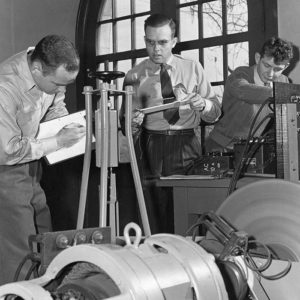 In 1942, nine months after the US entered World War II, the Manhattan Project was launched in the global race to develop the first atomic bomb. The town of Oak Ridge, Tennessee, was established by the Army Corps of Engineers as the home of Clinton Engineer Works—the precursor to Oak Ridge National Laboratory, now the country’s premier national laboratory. The facility produced the enriched uranium that was used in the bombing of Hiroshima, Japan, in 1945.
In 1942, nine months after the US entered World War II, the Manhattan Project was launched in the global race to develop the first atomic bomb. The town of Oak Ridge, Tennessee, was established by the Army Corps of Engineers as the home of Clinton Engineer Works—the precursor to Oak Ridge National Laboratory, now the country’s premier national laboratory. The facility produced the enriched uranium that was used in the bombing of Hiroshima, Japan, in 1945.
From the beginning, the laboratory’s partnership with the University of Tennessee has fueled an era of American research innovation with deep roots in East Tennessee. UT faculty taught safety courses for Manhattan Project workers in the early years, and newly developed PhD programs gave project engineers a way to advance their education.
A s the lab established its new identity and shifted its focus after the war, the partnership solidified. Over the following decades, it has been strengthened by consortia, joint faculty appointments, cooperative agreements, and shared discoveries in genetics, energy science, and other fields. The Science Alliance, formally linking UT science operations and ORNL, was established by the State of Tennessee in 1984.
s the lab established its new identity and shifted its focus after the war, the partnership solidified. Over the following decades, it has been strengthened by consortia, joint faculty appointments, cooperative agreements, and shared discoveries in genetics, energy science, and other fields. The Science Alliance, formally linking UT science operations and ORNL, was established by the State of Tennessee in 1984.
Since 1999, the UT System has co-managed ORNL in partnership with Battelle Memorial Institute through UT–Battelle. With that strengthened connection has come a wave of discovery made possible by materials science, nanoscale science, and the power of high-performance computing—a wave that continues to build. Notable among numerous joint ventures are the 2006 establishment of the Governor’s Chair program, which draws top researchers in fields ranging from nuclear security to advanced manufacturing to molecular biophysics, and the 2011 creation of the Bredesen Center for Interdisciplinary Research and Graduate Education to provide world-class doctoral education.
The UT–ORNL Joint Institute for Nuclear Physics and Applications was involved in a particularly exciting scientific discovery in 2016: the development of a process that measures the decay of nuclear materials down to one millionth of a second, which was vital in proving the existence of a new element in the periodic table—117, named tennessine in honor of team members from ORNL, UT, and Vanderbilt University.
 The newly created Oak Ridge Institute at UT aims to align the full portfolio of UT–ORNL joint programs to provide more interdisciplinary academic paths for students, develop new opportunities for industry partnerships, and create an atmosphere for groundbreaking team-led research.
The newly created Oak Ridge Institute at UT aims to align the full portfolio of UT–ORNL joint programs to provide more interdisciplinary academic paths for students, develop new opportunities for industry partnerships, and create an atmosphere for groundbreaking team-led research.
Throughout all of these developments, the partnership between ORNL and UT has provided UT students a window into a world-class research facility. On a wider scale, it has led to regional investments across a range of industries. The two institutions anchor the Oak Ridge Corridor, home to scientists, educators, innovators, makers, and entrepreneurs. Together these creative minds are building a new American hub of innovation and economic development.
—
Sources: Oak Ridge National Laboratory Review, Vol. 51, No. 3, 2018; A Timeline of ORNL Science; 225.utk.edu history timeline; Breaking the Mold: The University of Tennessee, Battelle, and the Resurgence of Oak Ridge National Laboratory

